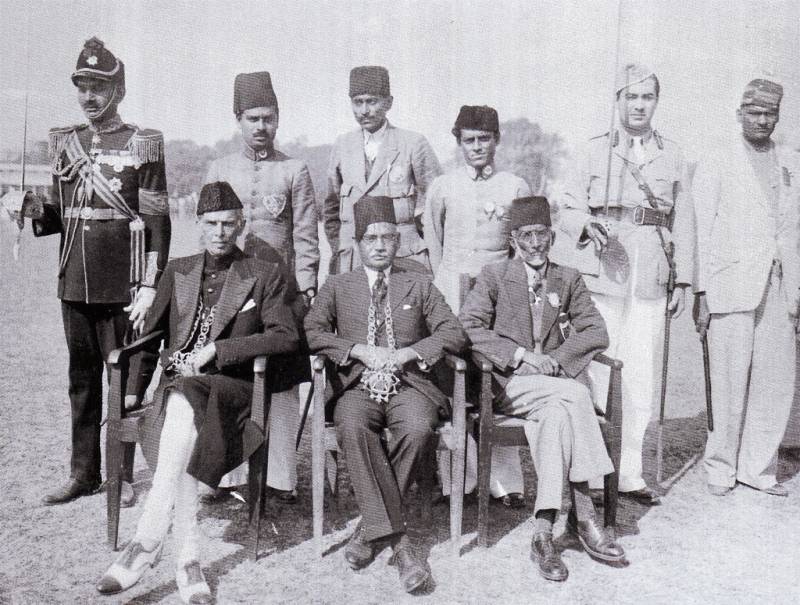The All India Muslim League is credited with the foundation of Pakistan, in the official history of the country. While the Muslim League claimed to represent the interests of Indian Muslim community, it was not a lone voice or a particularly representative one. Christophe Jaffrelot, in his excellent book, ‘The Pakistan Paradox’ has highlighted the journey of Muslim League from an exclusive Elites-only club, to the voice of Indian Muslims in a chapter titled “An Elite’s search for a Nation, and country’. During the time of Sir Syed Ahmad Khan (1817-1898), Muslim Elite (Ashraaf) vied for government patronage and shied away from political movements such as Indian National Congress (formed in 1885). By the turn of the twentieth century, Aligarh movement started by Sir Syed had managed to form a critical mass of educated Muslims among the Ashraaf who demanded political concessions from the British Government.
Two graduates of Aligarh, Mohsin-ul-Mulk and Imad-ul-Mulk drafted a memorandum to demand greater political representation for Muslims in 1905. Their text restated the ‘political importance’ of Indian Muslims, in view of ‘the position which they occupied in India a little more than a hundred years ago’, to ask for better representation both in government service where they were losing ‘in the prestige and influence which are justly their due’ and in elected assemblies at both the local and provincial level. The memorandum demanded that Muslims should be represented separately in the newly augmented Provincial legislative councils according to ‘the numerical strength, social status, local influence and special requirements of either Community’.
This memorandum was presented to the Viceroy of India in 1906 by a delegation of Muslims, known as the Shimla Delegation. The delegation consisted predominantly of Aligarh officials and notables. Only 11 out of 35 members of Shimla deputation were not titled. Mr. Mohammad Ali Jinnah, a lawyer and member of All India Congress based in Bombay wasn’t amused by the Shimla Deputation, as recalled by Khushwant Singh in his book ‘Jinnah, India, Partition’. Mr. Singh reproduced a letter than Jinnah sent to a Bombay newspaper named ‘Gujarati’ disapproving the composition and vague demands of the deputation. In the letter, Mr. Jinnah wrote: “Dear Sir, It has been given out in the papers including your paper that a representative deputation of Mahomadans of India is going to wait upon the Viceroy on the 1st October. May I know whoever elected the gentlemen who are supposed to represent Bombay? It is such a pity that some people are always assuming the role of representatives without the smallest shadow of ground or foundation for it. I know of no meeting of the Mahomadan community that appointed these worthies to represent Bombay. Then another thing is this: May I know what is the object of the deputation? Nobody up to now knows what the deputation proposed to do. Is this the way to speak in the name of millions without even informing them what is going to be done for them, to say nothing of the fact that nothing has been done to ascertain the real views of the
Mahomadans of this city in the matter?”
A conference of Muslim educationists, landowners and community leaders was later called in Dhaka. On 30th December 1906, the ‘Muhammaden Educational conference’ became the Muslim League, under the auspices of the Nawab of Dhaka. The founding members included 11 members from UP, 7 Punjabis and a single Bengali. In 1917, the percentage of Indian Muslims residing in UP was 4.1 while 54.8% were based in Punjab. There was a clear bias towards ‘Muslim Minority’ provinces in the party from the very beginning.
The All-India Muslim League retained its status as a representative of the Muslim Elite, even in Bengal. Till the 1930s, the party’s membership consisted mainly of Urdu-speaking elites, dissociated from issues of the common men and women of the area. The Nawab of Dhaka’s family had migrated from Kashmir in the eighteenth century. The British awarded them title of ‘Nawab’ due to their support for East India Company during the Mutiny of 1857. Most of the elite did not speak the local language (Bengali) and didn’t care much about the local culture.
Till the beginning of Second World War, All India Muslim League was an insignificant political party with fewer Muslim members than Indian National Congress. The increasing role of Ulema in political affairs—which reached its epoch during the ill-advised Khilafat movement—forced Muslim league to collaborate with the clergy during elections, particularly in United Provinces (UP). This collaboration, in turn, diluted the already meagre political clout of Muslim League. Mr. Jinnah, despite his earlier scepticism had joined All India Muslim League and had tried his best to act as an Ambassador of Hindu-Muslim unity for many decades. He gave up politics for a few years in the early 1930s and moved to Britain. He was goaded by some members of Muslim League into returning to India and leading the Muslim Nationalist movement in 1936.
All India Muslim League fared badly in the elections held in 1937. In Punjab, it won only one seat as opposed to the Unionist Party—composed primarily of Punjabi landowners—which won 95 seats. The only province where Muslim League did well electorally was UP but even then Congress was able to form a government without the support of Muslim League. In March 1940, Muslim League identified a goal for expressing Muslim Nationalist sentiments: separate Muslim Homeland(s) in areas with Muslim majority population. The British were clearly unable to continue their rule over India after Second World War and Partition of India was almost an inevitable conclusion. The educated, salaried class in Muslim minority provinces did not foresee their future in a United India and were the primary force behind the ‘Pakistan Movement’. It is an irony of history that the people belonging to areas constituting Pakistan today were not too enthused by the idea of ‘Pakistan’ themselves.






